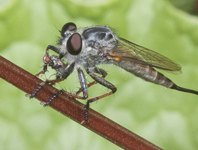Abstract
A new species belonging to the subgenus Isonychia, of the genus Isonychia Eaton, 1871, is described based on larvae and imagoes collected from Moyar River, Nilgiri District, Tamil Nadu, India. The imagoes of I. moyarensis n. sp. can be distinguished from other described Oriental species of Isonychia (Isonychia) by the combination of characters: (i) forewing with rusty brown maculae in the costal, subcostal, and median areas; (ii) femur and tibia brown, fore leg pale, apices of tarsal segments brownish; (iii) males with distal angles of penes rounded, without serrations; (iv) second segment of gonostylus uniformly convex; and (v) sterna of tenth abdominal segment in female deeply cleft. Isonychia (Isonychia) moyarensis n. sp. can be distinguished in the larval stage from other known Oriental species by the following combination of characters: (i) abdominal terga II–IX with median dark brown maculae progressively larger with dark brown slanting streaks in lateral margins; (ii) trachea of abdominal gills I–VII unbranched; (iii) posterolateral projections on abdominal segments I–VII blunt and progressively longer than those of segments VIII–IX, sharp and distinct; and (iv) abdominal terga X pale yellow in anterior ⅓, and dark brown in the posterior ⅔. A key to the known larvae of Oriental species of Isonychia is also provided.
References
Bauernfeind, E. & Soldán, T. (2012) The mayflies of Europe (Ephemeroptera). Apollo Books, Ollerup, 781 pp.
Edmunds, G.F. Jr. & Polhemus, D.A. (1990) Zoographical patterns among mayflies (Ephemeroptera) in the Malay Archipelago, with special reference to Celebes. In: Knight, W.J. & Holloway, J.D. (Eds.), Insects and the rain forest of Southeast Asia. Royal Entomological Society of London, London, pp. 49–50.
Kang, S.C. & Yang, C.T. (1994) The nymph of Isonychia formosana (Ephemeroptera: Oligoneuriidae). Journal of Taiwan Museum, 47, 1–3.
Kondratieff, B.C. & Voshell, J.R. Jr. (1983) Subgeneric and species-group classification of the mayfly genus Isonychia in North America (Ephemeroptera: Oligoneuriidae). Proceedings of the Entomological Society of Washington, 85 (1), 128–138.
Kondratieff, B.C. & Voshell, J.R. Jr. (1984) The North and Central American species of Isonychia (Ephemeroptera: Oligoneuriidae). Transactions of the American Entomological Society, 110, 129–244.
Landa, V. (1973) A contribution to the evolution of the order Ephemeroptera based on comparative anatomy. In: Peters, W.L. & Peters, J.G. (Eds.), Proceedings of the first international conference on Ephemeroptera. E.J. Brill, Leiden, pp. 155–159.
McCafferty, W.P. (1989) Characterization and relationships of the subgenera of Isonychia (Ephemeroptera: Oligoneuriidae). Entomological News, 100 (2), 72–78.
McCafferty, W.P. (1991) Toward a phylogenetic classification of the Ephemeroptera (Insecta): a commentary on systematics. Annals of the Entomological Society of America, 84 (4), 343–360.
https://doi.org/10.1093/aesa/84.4.343
Saito, R., Jo, J., Sekine, K., Bae, Y.J. & Tojo, K. (2016) Phylogenetic analyses of the isonychiid mayflies (Ephemeroptera: Isonychiidae) in the northeast Palearctic region. Entomological Research, 46, 246–259.
https://doi.org/10.1111/1748-5967.12168
Sartori, M., Derleth, P. & Gattolliat, J.-L. (2003) New data about the mayflies (Ephemeroptera) from Borneo. In: Gaino, E. (Ed.), Research Update on Ephemeroptera and Plecoptera. University of Perugia, Perugia, pp. 403–406.
Sivaramakrishnan, K.G. & Subramanian, K.A. (2016) Mayflies (Ephemeroptera) of the Western Ghats: Biogeographic patterns and diversity profiles. In: Priyadarsanan, D.R., Soubadra Devy, M., Subramanian, K.A., Aravind, N.A. & Seena, N.K. (Eds.), Invertebrate Diversity and Conservation in the Western Ghats, India. Ashoka Trust for Research in Ecology and the Environment (ATREE), Bengaluru, pp. 69–86.
Sivaramakrishnan, K.G. (2016) Systematics of the Ephemeroptera of India: Present status and future prospects. Zoosymposia, 11, 33–52.
https://doi.org/10.11646/zoosymposia.11.1.8
Soldán, T. (2001) Status of the systematic knowledge and priorities in Ephemeroptera studies: the Oriental region. In: Dominguez, E. (Ed.), Trends in Research in Ephemeroptera and Plecoptera. Kluwer Academic/Plenum Publishers, New York, pp. 53–65.
https://doi.org/10.1007/978-1-4615-1257-8_9
Tiunova, T.M. & Gorovaya, E.A. (2010) A new species of the genus Isonychia Eaton, 1871 (Ephemeroptera, Isonychiidae) from the Far East of Russia. Euroasian Entomological Journal, 9 (3), 341–344 + I.
Tiunova, T.M., Kluge, N.J. & Ishiwata, S. (2004) Revision of the East Palaearctic genus Isonychia (Ephemeroptera: Isonychiidae). The Canadian Entomologist, 136, 1–41.
https://doi.org/10.4039/n02-108
Tungpairojwong, N. & Boonsoong, B. (2011) New records of Isonychia formosana, Prosopistoma annamense and Prosopistoma sinense (Ephemeroptera) from Thailand. Entomological Research, 41 (2), 66–69.
https://doi.org/10.1111/j.1748-5967.2011.00317.x
You, D.S. & Su, C. (1987) Descriptions of the nymphs of Choroterpes nanjingensis, Potamanthodes fujianensis and Isonychia kiangsinensis (Ephemeroptera: Leptophlebiidae, Potamanthidae, Siphlonuridae). Acta Zootaxonomica Sinica, 12 (3), 332–336.

